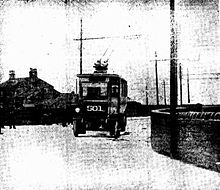Leeds Trolleybus

An original Leeds trolleybus, ca. 1912.
|
|||||||||||||
| Operation | |||||||||||||
|---|---|---|---|---|---|---|---|---|---|---|---|---|---|
| Locale | Leeds, West Riding of Yorkshire, England | ||||||||||||
|
|||||||||||||
|
|||||||||||||
The Leeds trolleybus system served the West Riding of Yorkshire city of Leeds in England between 1911 and 1928. In May 2016, plans to construct a new system, the New Generation Transport (NGT) project, were refused approval from the UK Department for Transport, following a negative report from the planning inquiry.
The original system was one of the first two trolleybus systems in the United Kingdom, along with Bradford. Both systems commenced operation on 20 June 1911, but public service in Bradford did not start until four days later. The Leeds system had three routes, and closed on 26 July 1928.
The original Leeds route, operated by Leeds Tramways, was from City Square to Moor Top via Lower Wortley and Farnley.
The route was launched at Thirsk Row, off Wellington Street on 20 June 1911. The first of two buses to set off on the first official run was driven by the Lord Mayor, William Middlebrook, and the second by his deputy, Frederick James Kitson. Both buses went on a round trip to Farnley, four miles from Leeds, returning 45 minutes later.
When the original route commenced operation, it had four trolleybuses. They were manufactured by the Railless Electric Traction Company, and powered by Siemens motors. They had solid rubber tyres and carried 28 passengers, who paid their fares when boarding. Known officially as "trackless cars" to distinguish them from trams, they ran on rural routes, to which trams were not suited.
In 1915 two further routes were opened, unconnected to the first route and operated from a stone depot at Guiseley, which still exists. These were feeder routes to the tram system.
The three routes were:
The system was not hugely successful. There was controversy between Leeds Corporation and the various councils over several issues relating to its operation. As time passed, internal combustion engined buses became more competitive. They soon replaced the trolleybuses, which closed on 26 July 1928.
Following the failure of plans for a Leeds Supertram network, which was rejected by the Department of Transport as being too costly in November 2005, the public transport provider Metro proposed the construction of an electric bus network, at an estimated cost of £300 million. The trolleybus system would be similar to that operating in the French city of Lyon, and gained support from the Regional Transport Board in June 2007.
...
Wikipedia
